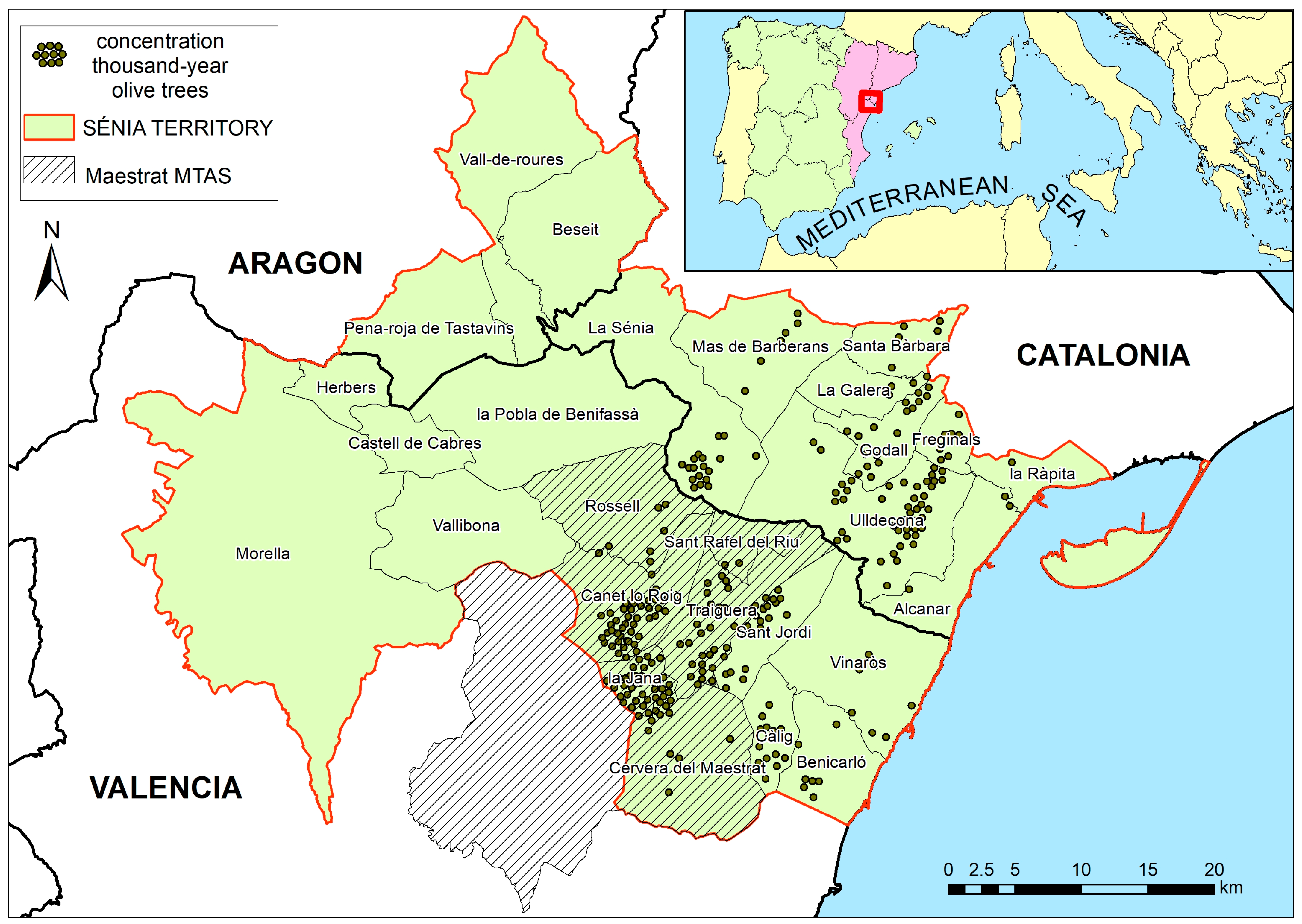The Precarious Survival of an Ancient Cultural Landscape: The Thousand-Year-Old Olive Trees of the Valencian Maestrat (Spain)
Abstract
1. Introduction
2. Methods and Case Study
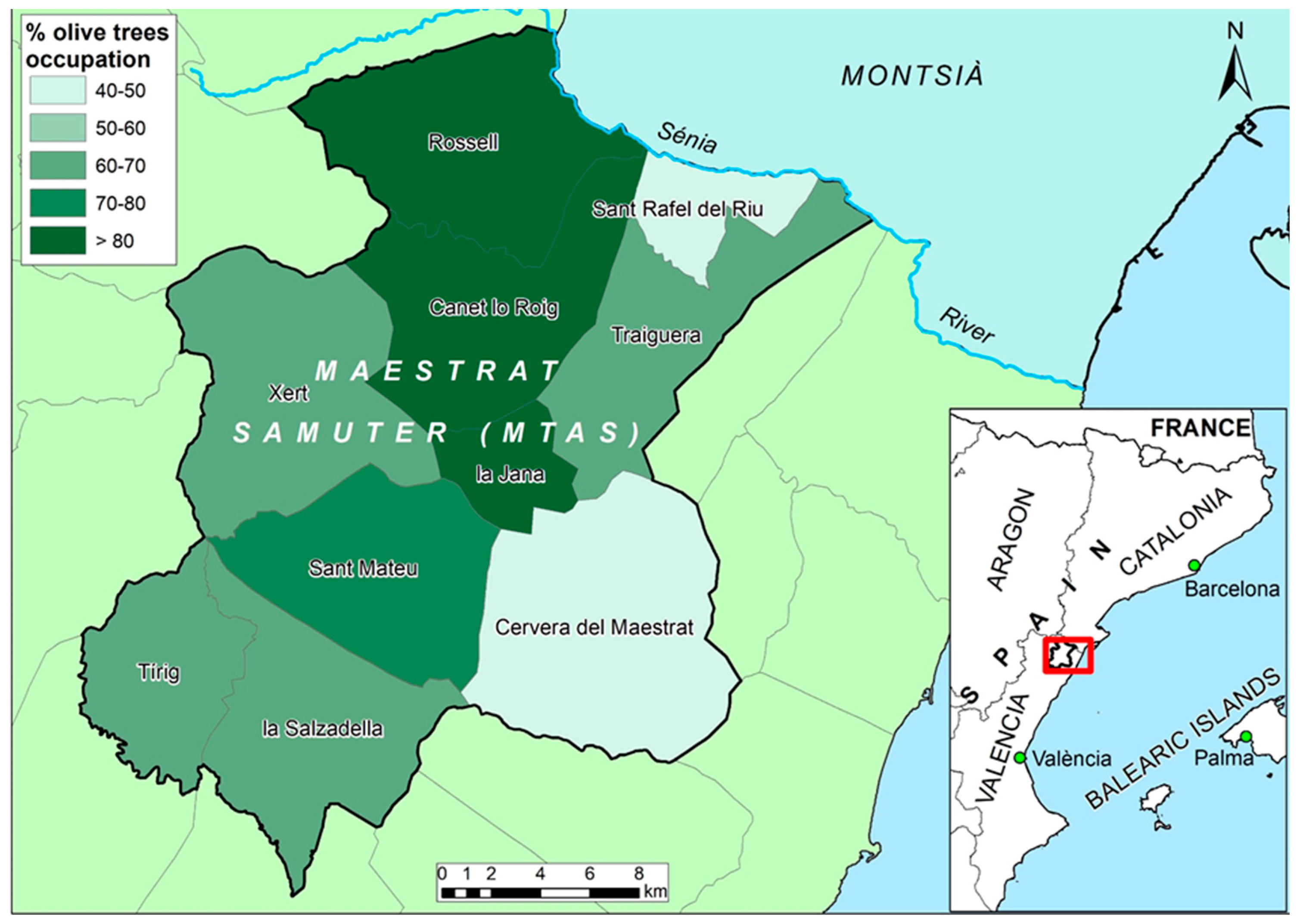
3. Results
3.1. Intrinsic Values
3.1.1. Representativeness
3.1.2. Authenticity
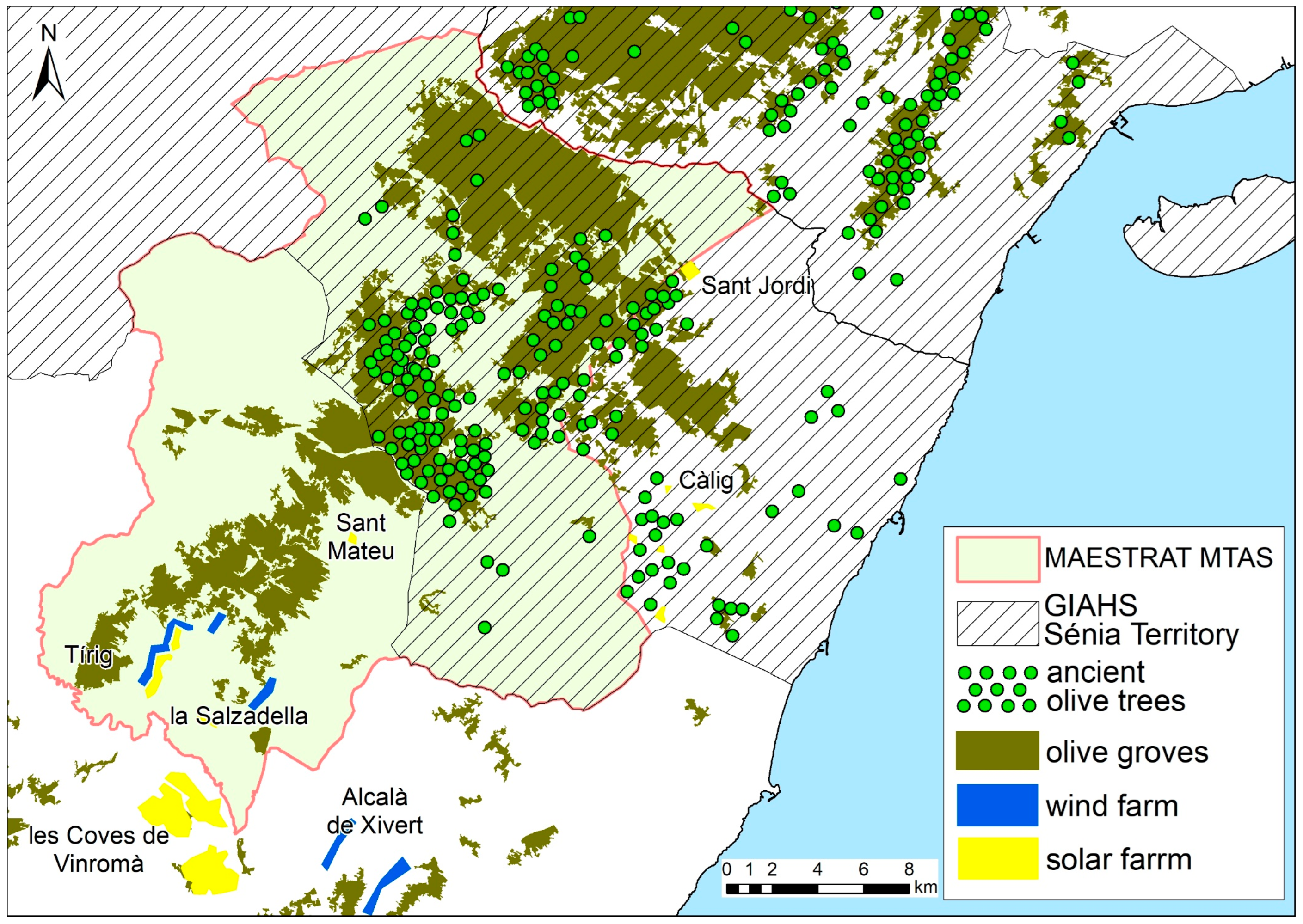
3.1.3. Ecological Integrity
3.1.4. Visibility and Visual Quality
3.2. Heritage Values
3.2.1. Historic
3.2.2. Social
3.2.3. Symbolic/Identity
3.2.4. Artistic
3.2.5. Informative/Scientific
3.3. Potential and Viability Values
3.3.1. Food Production, Security, and Quality
3.3.2. Awareness among Social Stakeholders
3.3.3. Participation and Integration of Local Communities
3.3.4. Socio-Economic Profitability
3.3.5. Vulnerability
3.3.6. Accessibility
4. Discussion
5. Conclusions
Author Contributions
Funding
Institutional Review Board Statement
Informed Consent Statement
Data Availability Statement
Conflicts of Interest
References
- Manningtyas, R.D.T.; Furuya, K. Traditional Ecological Knowledge versus Ecological Wisdom: Are They Dissimilar in Cultural Landscape Research? Land 2022, 11, 1123. [Google Scholar] [CrossRef]
- Shen, J.; Chou, R.-J. Cultural landscape development integrated with rural revitalization: A case study of Songkou ancient town. Land 2021, 10, 406. [Google Scholar] [CrossRef]
- Poudevigne, I.; Van Rooi, J.S.; Morin, P.; Alard, D. Dynamics of rural landscapes and their main driving factors: A case study in the Seine Valey, Normandy, France. Landsc. Urban Plan. 1997, 38, 93–103. [Google Scholar] [CrossRef]
- Armesto-López, X.A. Notas teóricas en torno al concepto de postproductivismo agrario. Investig. Geogr. 2005, 36, 137–156. [Google Scholar] [CrossRef]
- Sanz-Cañada, J.; Muchnik, J. Geographies of Origin and Proximity: Approaches to Local Agro-Food Systems. Cult. Hist. Digit. J. 2016, 5, e002. [Google Scholar] [CrossRef]
- Martínez-Arnáiz, M.; Baraja-Rodríguez, E.; Herrero-Luque, D. Multifunctional Territorialized Agri-Food Systems, Geographical Quality Marks and Agricultural Landscapes: The Case of Vineyards. Land 2022, 11, 457. [Google Scholar] [CrossRef]
- Zimmerer, K.S.; Vanek, S.J. Toward the Integrated Framework Analysis of Linkages among Agrobiodiversity, Livelihood Diversification, Ecological Systems, and Sustainability amid Global Change. Land 2016, 5, 10. [Google Scholar] [CrossRef]
- Sanz-Cañada, J.; García-Azcárate, T. Paisajes, patrimonio y gobernanza territorial de los sistemas agroalimentarios locales. Estud. Geogr. 2020, 81, e043. [Google Scholar] [CrossRef]
- Simelton, E.; Carew-Reid, J.; Coulier, M.; Damen, B.; Howell, J.; Pottinger-Glass, C.; Tran, H.V.; Van Der Meiren, M. NBS Framework for Agricultural Landscapes. Front. Environ. Sci. 2021, 9, 678367. [Google Scholar] [CrossRef]
- Wylie, J. Landscape; Routledge: London, UK, 2007. [Google Scholar]
- Stephenson, J. The Cultural Values Model: An integrated approach to values in landscapes. Landsc. Urban Plan. 2008, 84, 127–139. [Google Scholar] [CrossRef]
- Cosgrove, D. Geography is everywhere: Culture and symbolism in human landscapes. In Horizons in Human Geography; Palgrave: London, UK, 1989; pp. 118–135. [Google Scholar] [CrossRef]
- Roe, M. Food and landscape. Landsc. Res. 2016, 41, 709–713. [Google Scholar] [CrossRef]
- Brulotte, R.L.; Giovine, M.A. (Eds.) Edible Identities: Food as Cultural Heritage; Routledge: Abingdon, UK, 2016. [Google Scholar]
- Runge, T. Implementation of Eco-schemes in Fifteen European Union Member States. EuroChoices 2022, 21, 19–27. [Google Scholar] [CrossRef]
- Antich, J. Conservación y puesta en valor de los olivos milenarios del Territorio Sénia. Boletín Del Inst. Andal. Del Patrim. Histórico 2014, 22, 2–4. [Google Scholar] [CrossRef]
- Camaioni, C.; D’Onofrio, R.; Pierantoni, I.; Sargolini, M. Vineyard landscapes in Italy: Cases of territorial requalification and governance strategies. Landsc. Res. 2016, 41, 714–729. [Google Scholar] [CrossRef]
- Flinzberger, L.; Cebrián-Piqueras, M.A.; Peppler-Lisbach, C.; Zinngrebe, Y. Why geographical indications can support sustainable development in European agri-food landscapes. Front. Environ. Sci. 2022, 2, 121. [Google Scholar] [CrossRef]
- Agnoletti, M.; Emanueli, F.; Corrieri, F.; Venturi, M.; Santoro, A. Monitoring traditional rural landscapes. The case of Italy. Sustainability 2019, 11, 6107. [Google Scholar] [CrossRef]
- Blanc, J.F. Landscape typology of French agrarian terraces. In World Terraced Landscapes: History, Environment, Quality of Life; Springer: Cham, Switzerland, 2019; pp. 63–77. [Google Scholar] [CrossRef]
- Infante-Amate, J. The ecology and history of the Mediterranean olive grove: The Spanish great expansion, 1750–2000. Rural Hist. 2012, 23, 161–184. [Google Scholar] [CrossRef]
- Castillo, P. Roman roads and waterways in the Roman Province Baetica: The relationship Via Augusta–Baetis (Guadalquivir) in the economic conquest via the rivers. Water Hist. 2023, 15, 81–103. [Google Scholar] [CrossRef]
- Arnan, X.; López, B.C.; Martínez-Vilalta, J.; Estorach, M.; Poyatos, R. The age of monumental olive trees (Olea europaea) in northeastern Spain. Dendrochronologia 2012, 30, 11–14. [Google Scholar] [CrossRef]
- Terral, J.F.; Alonso, N.; Buxó, R.; Chatti, N.; Fabre, L.; Fiorentino, G.; Marinval, P.; Pérez-Jordà, G.; Pradat, B.; Rovira, N.; et al. Historical biogeography of olive domestication (Olea europaea L.) as revealed by geometrical morphometry applied to biological and archaeological material. J. Biogeogr. 2004, 31, 63–77. [Google Scholar] [CrossRef]
- Barranco, D.; Barranco-Navero, D.; Rallo-Romero, L. El Cultivo del Olivo; Mundiprensa: Madrid, Spain, 2008. [Google Scholar]
- Buttel, F.H. Sustaining the unsustainable: Agro-food systems and environment in the modern world. In Handbook of Rural Studies; SAGE Publications Ltd.: Thousand Oaks, CA, USA, 2006; pp. 213–229. [Google Scholar] [CrossRef]
- Laestadius, L.I.; Wolfson, J.A. Unsustainable societal demands on the food system. In Environmental Nutrition; Academic Press: Cambridge, MA, USA, 2019; pp. 75–100. [Google Scholar] [CrossRef]
- Araújo, R.G.; Chavez-Santoscoy, R.A.; Parra-Saldívar, R.; Melchor-Martínez, E.M.; Iqbal, H.M. Agro-Food Systems and Environment–Sustaining the Unsustainable. Curr. Opin. Environ. Sci. Health 2022, 31, 100413. [Google Scholar] [CrossRef]
- Mayordomo-Maya, S.; Hermosilla-Pla, J. Evaluación del patrimonio cultural: La Huerta de Valencia como recurso territorial. Bol. Asoc. Geogr. Esp. 2019, 82, 8. [Google Scholar] [CrossRef]
- Mayordomo-Maya, S.; Hermosilla-Pla, J. Evaluation of Landscape Quality in Valencia’s Agricultural Gardens—A Method Adapted to Multifunctional, Territorialized Agrifood Systems (MTAS). Land 2022, 11, 398. [Google Scholar] [CrossRef]
- Membrado-Tena, J.C. Interpreting protohistoric societies through place names of landscape features: A case study in València, Spain. Landsc. Res. 2021, 46, 811–827. [Google Scholar] [CrossRef]
- Gkoltsiou, A.; Athanasiadou, E.; Paraskevopoulou, A.T. Agricultural Heritage Landscapes of Greece: Three Case Studies and Strategic Steps towards Their Acknowledgement, Conservation and Management. Sustainability 2021, 13, 5955. [Google Scholar] [CrossRef]
- Cassatella, C.; Peano, A. Landscape Indicators. Assessing and Monitoring Landscape Quality; Springer: Berlin/Heidelberg, Germany, 2022; Available online: https://link.springer.com/book/10.1007/978-94-007-0366-7 (accessed on 17 May 2023).
- Cutaia, F. Strategic Environmental Assessment: Integrating Landscape and Urban Planning; Springer: Berlin/Heidelberg, Germany, 2016; Available online: https://link.springer.com/book/10.1007/978-3-319-42132-2 (accessed on 17 May 2023).
- Statistical Portal of Generalitat Valenciana (Portal Estadístic de la Generalitat Valenciana). Territorial Data Bank. Estimates of Cultivated Areas by Municipality; (Banc de Dades Territorial. Estimacions de superfícies de cultiu per municipis). 2023. Available online: https://pegv.gva.es/va/ (accessed on 17 May 2023).
- Municipal Commonwealth Taula del Sénia (Mancomunitat Taula del Sénia). Sistema Agrícola Olivos Milenarios Territorio Sénia. 2018. Available online: https://www.fao.org/3/CA3148ES/ca3148es.pdf (accessed on 17 May 2023).
- Valencian Cartographic Institute (Institut Cartogràfic Valencià). Renewable Energies (Energies Renovables). Direcció General de Política Territorial i Paisatge de la Generalitat Valenciana. Available online: https://visor.gva.es/visor/ (accessed on 17 May 2023).
- European Environmental Agency. Corine Land Cover (CLC) 2018. Available online: https://land.copernicus.eu/pan-european/corine-land-cover/clc2018 (accessed on 17 May 2023).
- Silva-Pérez, R.; Fernández-Salinas, V. Desacuerdos entre patrimonio, paisaje y medio ambiente: A propósito de Punta Nati (Reserva de la Biosfera de la Unesco en Menorca). Doc. D’anàlisi Geogràfica 2020, 66, 0423–0444. [Google Scholar] [CrossRef]
- Rey, P.J. Preserving frugivorous birds in agro-ecosystems: Lessons from Spanish olive orchards. J. Appl. Ecol. 2011, 48, 228–237. [Google Scholar] [CrossRef]
- Verhoog, H.; Matze, M.; Van Bueren, E.L.; Baars, T. The role of the concept of the natural (naturalness) in organic farming. J. Agric. Environ. Ethics 2003, 16, 29–49. [Google Scholar] [CrossRef]
- Alonso, N. Cultivos y producción agrícola en época ibérica. Segvntvm 2000, 3, 25–46. Available online: https://repositori.udl.cat/handle/10459.1/57676 (accessed on 17 May 2023).
- Trillo, C. El paisaje vegetal en la Granada Islámica y sus transformaciones tras la conquista castellana. Hist. Agrar. 1999, 17, 131–152. Available online: https://historiaagraria.com/FILE/articulos/HA17_trillo.pdf (accessed on 17 May 2023).
- Kirchner, H.; Virgili, A.; Antolín, F. Un espacio de cultivo urbano en al-Andalus: Madîna Turtûsa (Tortosa) antes de 1148. Hist. Agrar. 2014, 62, 11–45. Available online: https://www.historiaagraria.com/FILE/articulos/HA62__Kirchner.pdf (accessed on 17 May 2023).
- Spanish Official Gazette (Boletín Oficial del Estado). Law 4/2006 of 19 May 2006 on Monumental Tree Heritage. Generalitat Valenciana. 2006. Available online: https://www.boe.es/buscar/pdf/2006/BOE-A-2006-11581-consolidado.pdf (accessed on 17 May 2023).
- Rabasa-Edo, C.; Vivas-Gimeno, I. La interpretación del paisaje como herramienta para la dinamización local: Entre olivos milenarios y alcornoques en las comarcas de Castelló. Terra Rev. Desarro. Local 2020, 6, 323–330. [Google Scholar] [CrossRef]
- Luque-Revuelto, R.M. Las construcciones rurales en piedra seca como paradigma de sostenibilidad: Aportaciones didácticas y geográficas a partir de su declaración como Patrimonio Cultural Inmaterial de la Humanidad. Rev. Investig. Didact. Cienc. Soc. 2020, 6, 73–93. Available online: https://redined.educacion.gob.es/xmlui/handle/11162/197074 (accessed on 17 May 2023). [CrossRef]
- Silva-Pérez, R.; González-Romero, G. GIAHS as an Instrument to Articulate the Landscape and Territorialized Agrifood Systems—The Example of La Axarquía (Malaga Province, Spain). Land 2022, 11, 310. [Google Scholar] [CrossRef]
- Castellón Plaza. Castellón Plaza (21-12-2022). Available online: https://castellonplaza.com/empresa-sant-jordi-entra-top-10-mundial--mejores-aceites-produccion-limitada (accessed on 12 May 2023).
- Budí, V.; Rubert, J.J. El cultivo del olivo y la producción de aceite en la provincia de Castellón. In La innovación territorial y el empleo en la Comunidad Valenciana; Hermosilla, J., Ed.; Universitat de València: València, Spain, 2020; pp. 195–226. [Google Scholar]
- Casado-Montilla, J.; Pulido-Fernández, J.I.; Carrillo-Hidalgo, I.; Durán-Román, J.L. El oleoturismo como instrumento de diversificación productiva de las cooperativas olivícolas. Rev. De Estud. Coop. 2023, 143, e87969. [Google Scholar] [CrossRef]
- Rodríguez Cohard, J.C.; Sánchez Martínez, J.D.; Gallego Simón, V.J. The upgrading strategy of olive oil producers in Southern Spain: Origin, development and constraints. Rural Soc. 2017, 26, 30–47. [Google Scholar] [CrossRef]
- Rodríguez-Cohard, J.C.; Sánchez-Martínez, J.D.; Gallego Simón, V.J. Olive crops and rural development: Capital, knowledge and tradition. Reg. Sci. Policy Pract. 2019, 11, 935–949. [Google Scholar] [CrossRef]
- Delgado-Viñas, C.; Gómez-Moreno, M.L. The Interaction between Urban and Rural Areas: An Updated Paradigmatic, Methodological and Bibliographic Review. Land 2022, 11, 1298. [Google Scholar] [CrossRef]
- Hendrikse, G.; Bijman, J. Ownership structure in agrifood chains: The marketing cooperative. Am. J. Agric. Econ. 2002, 84, 104–119. Available online: https://onlinelibrary.wiley.com/doi/epdf/10.1111/1467-8276.00246 (accessed on 17 May 2023). [CrossRef]
- Karantininis, K.; Nilsson, J. (Eds.) Vertical Markets and Cooperative Hierarchies: The Role of Cooperatives in the Agri-Food Industry; Springer Science & Business Media: Dordrecht, The Netherlands, 2007. [Google Scholar]
- Mesa-Manzano, R.; Esparcia-Pérez, J. Difusión de innovaciones en la agricultura ecológica y análisis de redes sociales: Un ensayo de aplicación. An. De Geogr. De La Univ. Complut. 2021, 41, 133–159. [Google Scholar] [CrossRef]
- Albert, C.; Aronson, J.; Fürst, C.; Opdam, P. Integrating ecosystem services in landscape planning: Requirements, approaches, and impacts. Landsc. Ecol. 2014, 29, 1277–1285. [Google Scholar] [CrossRef]
- Angelstam, P.; Munoz-Rojas, J.; Pinto-Correia, T. Landscape concepts and approaches foster learning about ecosystem services. Landsc. Ecol. 2019, 34, 1445–1460. [Google Scholar] [CrossRef]
- Morri, E.; Santolini, R. Ecosystem services valuation for the sustainable land use management by nature-based solution (NbS) in the common agricultural policy actions: A case study on the Foglia river basin (Marche region, Italy). Land 2021, 11, 57. [Google Scholar] [CrossRef]
- Spennemann, D.H. The Shifting Baseline Syndrome and Generational Amnesia in Heritage Studies. Heritage 2022, 5, 2007–2027. [Google Scholar] [CrossRef]
- Pauly, D. Anecdotes and the shifting baseline syndrome of fisheries. Trends Ecol. Evol. 1995, 10, 430. [Google Scholar] [CrossRef]
- Vera, F. The shifting baseline syndrome in restoration ecology. In Restoration and History; Routledge: Oxfordshire, UK, 2010; pp. 116–128. [Google Scholar]
- Spennemann, D.H. The usefulness of the Johari Window for the Cultural Heritage Planning Process. Heritage 2023, 6, 724–741. [Google Scholar] [CrossRef]
- Moyano, E. La PAC y el Nudo Gordiano de los Derechos Históricos; Agronegocios; Eumedia: Petaling Jaya, Malaysia, 2020. Available online: https://www.agronegocios.es/agronegocios/la-pac-y-el-nudo-gordiano-de-los-derechos-historicos-por-eduardo-moyano-estrada-iesa-csic/ (accessed on 12 May 2023).
- Eistrup, M.; Sanches, A.R.; Muñoz-Rojas, J.; Pinto Correia, T. A “young farmer problem”? Opportunities and constraints for generational renewal in farm management: An example from Southern Europe. Land 2019, 8, 70. [Google Scholar] [CrossRef]
- Sroka, W.; Dudek, M.; Wojewodzic, T.; Król, K. Generational changes in agriculture: The influence of farm characteristics and socio-economic factors. Agriculture 2019, 9, 264. [Google Scholar] [CrossRef]

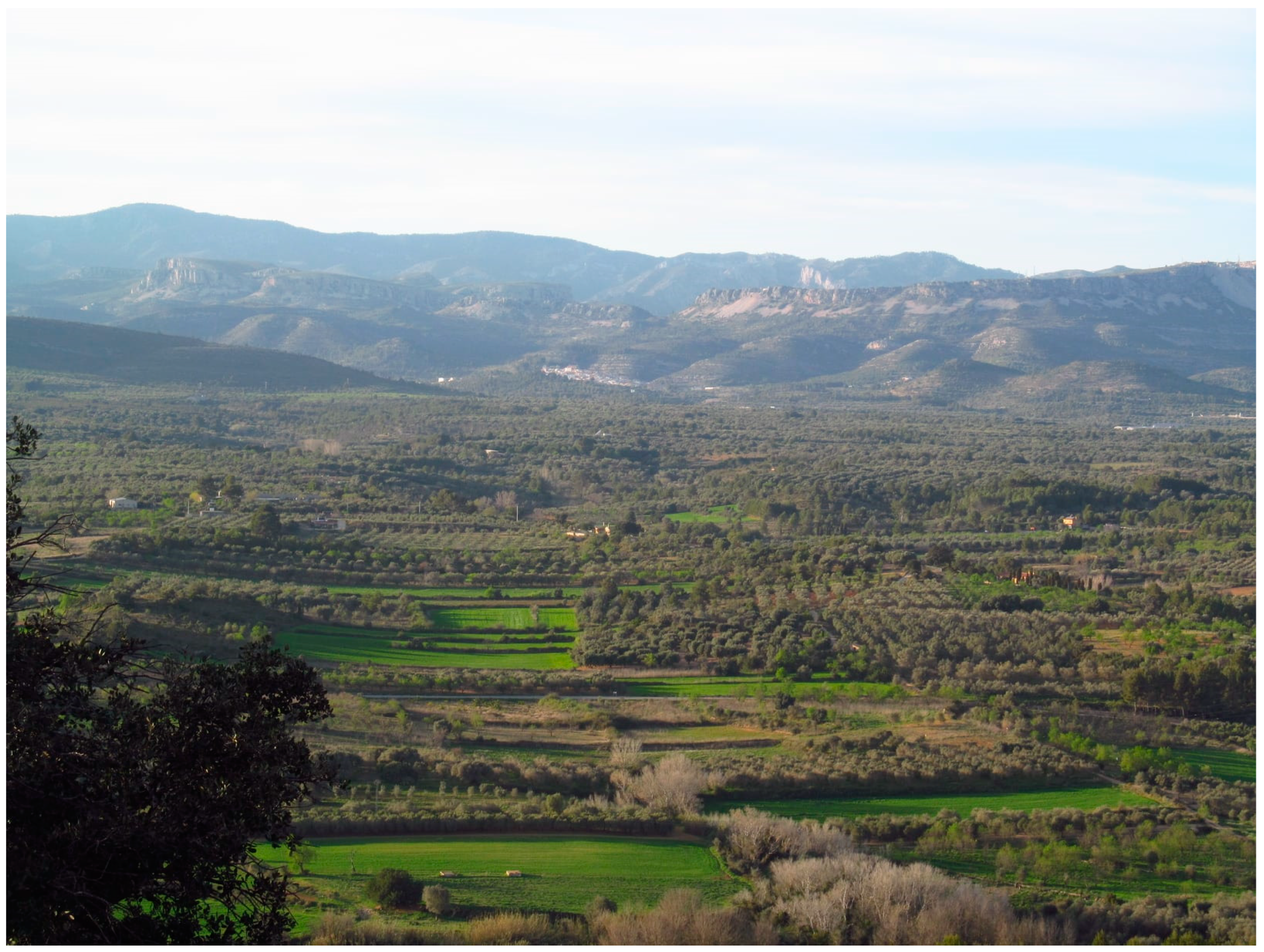
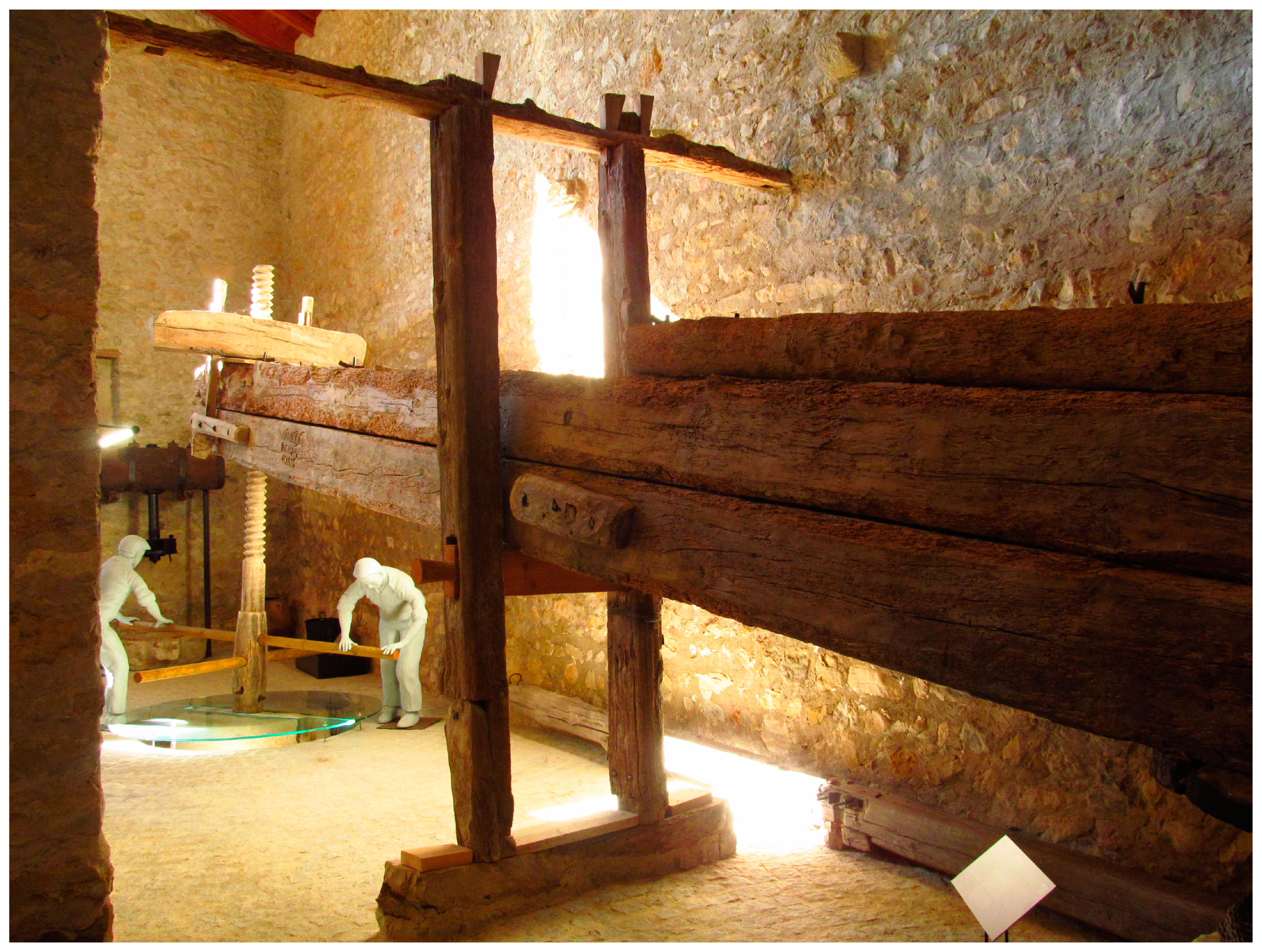

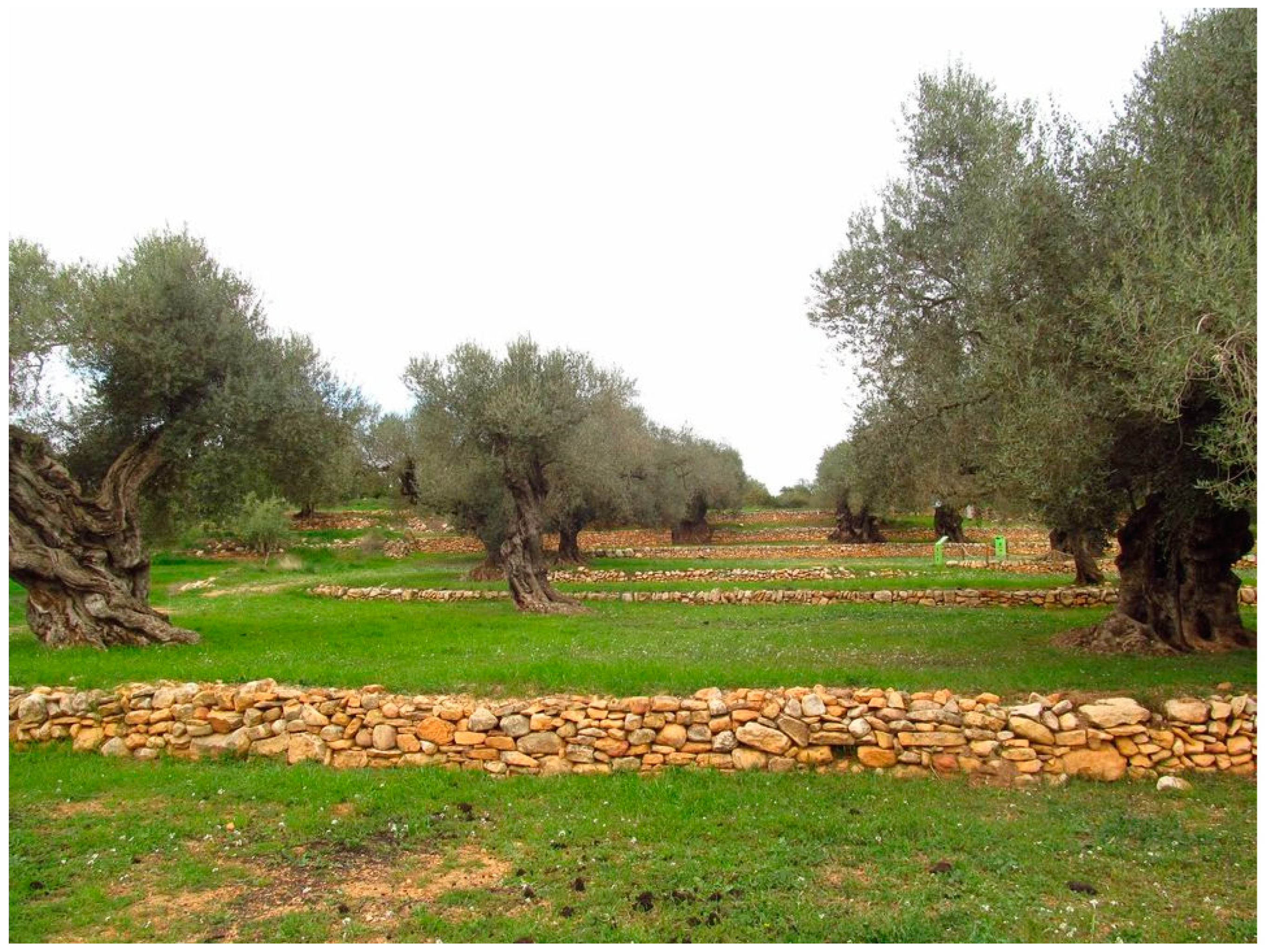
| Intrinsic Values | Representativeness | Heritage Values | Historic | Potential and Viability Values | Food production, security, and quality |
| Authenticity | Social | Awareness among social stakeholders | |||
| Ecological integrity | Symbolic/ Identity | Participation and integration of local communities | |||
| Visibility and visual quality | Artistic | Socio-economic profitability | |||
| Informative/Scientific | Vulnerability | ||||
| Accessibility |
Disclaimer/Publisher’s Note: The statements, opinions and data contained in all publications are solely those of the individual author(s) and contributor(s) and not of MDPI and/or the editor(s). MDPI and/or the editor(s) disclaim responsibility for any injury to people or property resulting from any ideas, methods, instructions or products referred to in the content. |
© 2023 by the authors. Licensee MDPI, Basel, Switzerland. This article is an open access article distributed under the terms and conditions of the Creative Commons Attribution (CC BY) license (https://creativecommons.org/licenses/by/4.0/).
Share and Cite
Membrado-Tena, J.C.; Hermosilla-Pla, J. The Precarious Survival of an Ancient Cultural Landscape: The Thousand-Year-Old Olive Trees of the Valencian Maestrat (Spain). Land 2023, 12, 1331. https://doi.org/10.3390/land12071331
Membrado-Tena JC, Hermosilla-Pla J. The Precarious Survival of an Ancient Cultural Landscape: The Thousand-Year-Old Olive Trees of the Valencian Maestrat (Spain). Land. 2023; 12(7):1331. https://doi.org/10.3390/land12071331
Chicago/Turabian StyleMembrado-Tena, Joan Carles, and Jorge Hermosilla-Pla. 2023. "The Precarious Survival of an Ancient Cultural Landscape: The Thousand-Year-Old Olive Trees of the Valencian Maestrat (Spain)" Land 12, no. 7: 1331. https://doi.org/10.3390/land12071331
APA StyleMembrado-Tena, J. C., & Hermosilla-Pla, J. (2023). The Precarious Survival of an Ancient Cultural Landscape: The Thousand-Year-Old Olive Trees of the Valencian Maestrat (Spain). Land, 12(7), 1331. https://doi.org/10.3390/land12071331










